The Canadian Medical Association (CMA) and the National Institute on Ageing reported recently that 96% of Canadians want to age in place. They want to stay in their own homes as long as possible and stay independent at the same time.
It may be something you or your loved ones are contemplating in the golden years. It’s a hot topic in our household, as the grandparents on both sides of the family continue to appreciate aging in place. An often overlooked aspect of aging in place is the importance of preventing a life-altering fall. As we age, our risk of falling increases, along with the likelihood that a fall will cause an injury. In fact, falls are the leading cause of injury among older Canadians, with 20 to 30 per cent of seniors experiencing one or more falls each year. Half of all falls happen in the home—the very place older adults spend most of their time. Since 2019, I have published six books geared to supporting seniors with fall prevention. My goals with these books are to help seniors:
Sometimes, though, seniors don’t want to hear about or discuss fall prevention. I’ve seen this firsthand at recent book signings. A senior will slow down to see the books on my display table. As soon as they register the topic, they’ll beat a hasty retreat. Some of them will shake their heads and tell me they don’t need fall prevention help. But the fact is a fall can happen at any time. And there are many factors that contribute to the risk of a fall:
If aging in place is on your radar, I hope this article will provide some practical tips to stay independent as long as possible. And while I regularly tout the benefits of regular physical activity to prevent falls, the non-exercise fall prevention tips are just as important as the exercise tips. They include:
And if you need help with the exercise side of fall prevention, please feel free to reach out. I can recommend one of my six publications, based on your requirements. Or you can find out more information in the books section. In closing, please indulge me while I share my favourite movement-based catchphrases and quotes:
0 Comments
There are many misconceptions about the concepts of introversion and extroversion, and I’m not here to school you on personality traits. There’s always Google and ChatGPT if you want to delve into it in more detail.
In a nutshell, I see myself as an introvert because I prefer to recharge my battery in private. If I don’t get a good dose of “cave time” every day, it impacts my ability to interact with others. Think babbling idiot who frequently inserts both feet in mouth, peppered with blank stares when engaged in conversation. Take your pick—my brain usually decides independently which option it will show the world when I’m spent: either my brain is in overdrive and can’t cope, or it shuts down completely (because it can’t cope). Since I’ve been introverting more and more these days, I’ve also been replaying in my head some of my not-so-stellar excursions as an extrovert. Like networking. For an introvert, networking can cause heart palpitations, sweaty palms, and a strong desire to flee. No fight-or-flight for this introvert—it’s flight all the time. At a time in my working life when networking was mandatory (downsizing meant I was switching careers), I sought advice from a business coach. “How do I handle networking events when all I want to do is run and hide?” “When you walk in a room, find the person standing alone and go talk to them. They’re probably feeling the same way.” That sounded much less overwhelming than walking up to a group of strangers, and it was something I could possibly attempt without passing out from overwhelm. His parting words stuck with me. “It works in social situations too.” I decided to put my newfound knowledge to the test when I was invited to a party. I knew the party hosts, but wasn’t sure I’d known anyone else there. I couldn’t rely on shadowing the hosts all evening, as they would be busy with hosting duties. When I arrived, several groups of strangers nearly scared me back to my cave. They seemed to know each other quite well, sharing inside jokes and family updates. I wandered around the spacious home, looking for someone I knew or, better yet, someone standing alone. My search led me to the kitchen, where a woman was standing near the sink, a few feet away from a group of partygoers. Here was my chance to practise my networking skills and hopefully make a new acquaintance. Try as I might, this woman resisted my attempts at conversation. Was I that bad at small talk?! I skulked out of the kitchen and hovered awkwardly on the outskirts of another group, nursing my bruised ego. A few moments later, I saw the object of my failed networking attempt emerge from the kitchen carrying a tray of hors d’oeuvres. She was hired to work the party, not interact with socially-awkward guests like me. I was equal parts relieved and mortified. It wasn’t me! I still beat a hasty retreat back to my cave. Feel free to laugh about my mishap. I laugh about it all the time, now that some time has passed.  As we age, we tend to slow down. Our muscles shrink, our vision blurs, and our reaction time diminishes. Together, all of these factors lead to an increased risk of falling. We can work on muscle strength to help avoid a fall. But sometimes, we need to take a break from standing up. During these sitting periods, chair exercises can help you strengthen your muscles and increase your confidence when you do have to stand up and move around. When you do chair exercises daily, you reduce the risk of falls. The movements increase blood flow and keep your joints active and lubricated. Chair exercises come in handy when you have limited mobility or find it hard to maintain your balance. Bottom line, you’re improving your balance while seated.
Here’s what one customer had to say:
“About as comfortable and easy to get with and go with. Has really helped me and the need for equipment is not a factor. It makes it clear that the best exercise equipment we have is our own bodies. We just have to have information on how to use them. Highly recommend and would give as a gift even as I know it to be valuable and worthy of giving and receiving and definitely using.” The book includes a series of workout plans, to help guide readers through four gentle, seated workouts that focus on balance, posture, strength, and flexibility. Each exercise includes step-by-step instructions, basic illustrations, and recommendations to make each exercise easier or harder. Several stores in Ottawa are selling this title; you can find out which ones by visiting the book section of my website. If you’re further afield, visit Amazon to purchase your copy today!
Exercise is a subset of physical activity that is: planned, structured, repetitive, and for the purpose of conditioning the body. It is safe to say that all exercise is movement, but not all movement is exercise. And that’s okay, because physical activity lies on a continuum, it’s not an all-or-nothing endeavour. I refer to this continuum as NEAT™ to Elite. What’s the alternative to exercise? NEAT™, non-exercise activity thermogenesis, or incidental activity. NEAT is all the ways your body burns energy that is not eating, sleeping, or dedicated exercises. NEAT relates to moving about in daily life. These small, brief muscular movements are just as important as that gym workout in burning calories. You need both exercise and non-exercise activity in your life, but it’s that non-exercise activity that we have lost in our daily lives. That movement has been replaced by appliances and apps—labour-saving devices that have robbed our bodies of the physical activity, or labour, that we used to do on a daily basis before the technological revolution made movement almost obsolete. NEAT™ is different than your workout at the gym because it relates to moving about in daily life. Research suggests that light physical activity like NEAT™ is as beneficial to older adults and previously sedentary individuals as more vigorous exercise is for younger and more physically fit Canadians. Our grandparents’ generation didn’t need fancy gym equipment or flashy workout gear. Their lives required more movement than our current way of living. There were no labour-saving devices like garage door openers, TV remotes, and online shopping. They didn’t outsource physically demanding tasks like housework and snow shovelling. They just moved—a lot. Looking at the other end of the physical activity continuum—i.e., vigorous exercise, or what I refer to as elite—tends to be associated with amateur and professional athletes. Even at the elite level, athletes are paying attention to the continuum of physical activity and adapting their training accordingly. They balance high intensity and lower intensity workouts on a daily basis; their “zero to 60” performance only kicks in at specific times. Only a small fraction of their training and competition time is spent at the high-performance level. Here’s how elite triathlete Patrick Smith explains it: “You have to find a balance. You can train at a nine or 10 but you have to be able to come back the next week, the next month, and stay injury-free.” They pace themselves, and so should you. Our bodies need both exercise and non-exercise activity every single day. Physical activity at any intensity helps prevent and manage chronic health conditions like heart disease, type 2 diabetes, and some forms of cancer. It also improves your mental health, by curtailing symptoms of anxiety and depression, and improving overall well-being. Physical activity that is accumulated in sporadic bouts throughout the day still reduces the risk of early death. Just because you can’t make it to the gym doesn’t mean you can’t be active. Rethink your activities: Go for a walk, play with your kids or grandkids, clean the house, or do some gardening. These are small steps that can lead to big change, because they get your body moving—to be physically active. About Move More, Your Life Depends On It: Need help fitting physical activity into your daily routine? Learn how to embed healthy habits into each day and improve your overall wellbeing. If you like accessible convenience, approachable information, and making a change for the better, then you’ll love this handy guidebook. Order your copy today!  Recently, I’ve noticed a trend in my behaviour: I’ve been focusing on life at home, eschewing my traditional public presence. And I don’t regret it for a moment. You could say I’m embracing JOMO—the joy of missing out. You’ve likely heard about the concept of FOMO— fear of missing out. The idea that you are missing out on fun being had by friends, family, even strangers, weighs heavily for some.
At the other end of the continuum is JOMO—the joy of missing out. Here’s how psychologist Susan Albers describes JOMO: “Think of JOMO as FOMO’s chill distant cousin. It’s the ability to focus on doing what truly makes you happy. That doesn’t mean you sit home alone with no social life. It means you’re selective with what you do without worrying about what others are doing.” I fall firmly in this camp, more so now than ever. I am happier at home, and I do not feel like I’m missing out on anything. And it’s not just because we’re experiencing the darkest days of winter. I am not in hibernation mode. Rather, I’m consciously choosing to eliminate certain activities from my life. This includes the relentless pursuit of relevance on social media and the constant need to create more and more content. I’ve also pulled back on public appearances for the foreseeable future. I am quite happy with doing less in the professional/business realm. You see, I spent many years hustling—both for my own business and as an employee working for others. And I’m tired. I no longer want to be part of hustle culture. A recent book that addresses this topic is You’re Not Lazy: Let Go of What’s Holding You Back So You Can Enjoy a Great Life by Lara Wellman. Lara is a fellow Ottawa entrepreneur and friend. Her book gets to the heart of what I’ve been feeling lately:
So if you’ve been noticing that my accounts have gone quiet, you would be right. And that’s a good thing. 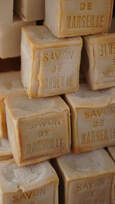 Image source: matthiasboeckel Image source: matthiasboeckel Next month, the French version of Shawna's Outreach will be available for sale. Until then, here's an excerpt from Shawna’s Outreach : En donnant tous un peu, on fait beaucoup. In the English version, you read about Hotel Hank: a bar of soap that was donated to Shawna's Outreach. In the French version, "a day in the life of a donation" is told through the eyes of Yvon le savon. As with its English counterpart, all proceeds from the sale of this book will go directly to helping feed people in need. Le parcours d’un don Faites connaissance avec Yvon d’Hôtel, le petit pain de savon que nous recevons, vous et moi, chaque fois que nous passons une nuit à l’hôtel. Son périple illustre la profonde influence que peut avoir le moindre article sur la vie de quelqu’un. Yvon d’Hôtel se morfond depuis au moins six mois sur les marches d’une maison de banlieue à Ottawa. Ne vous laissez pas tromper par sa modeste apparence : il voit grand. Tout ce qu’il souhaite, c’est de rencontrer l’Eau, son amie, et de contribuer à l’hygiène de quelqu’un. Comme il ne parvient jamais à atteindre une source d’eau, il n’a pas encore accompli sa mission. Du moins, jusqu’à aujourd’hui. 9 h 37 Un ballon de football abandonné dans l’escalier déstabilise Yvon d’Hôtel et l’envoie culbuter jusqu’au bas de l’escalier, où il arrive légèrement amoché. Le coupable de ce rebondissement ramasse Yvon d’Hôtel d’une main, alors que de l’autre, il s’active distraitement sur l’écran de son téléphone. 9 h 38 Le contenu qu’une amie vient d’afficher sur les réseaux sociaux au sujet de Shawna’s Outreach s’affiche à l’écran. Justement, le message donne une liste d’articles de toilette recherchés. 9 h 39 Les yeux alternent d’une main à l’autre, et passent d’Yvon d’Hôtel au billet publié sur Shawna’s Outreach. Une idée vient de surgir, et un plan s’élabore. 9 h 40 Un message arrive directement à Shawna’s Outreach : « Salut, j’ai un savon à donner. Comment dois-je faire? » 10 h 37 Yvon d’Hôtel arrive à un commerce situé à proximité qui sert de point de collecte à Shawna’s Outreach. D’ici quelques heures, Shawna passera prendre le contenu de la boîte de dons. Entre-temps, Yvon d’Hôtel patiente en compagnie des autres articles qui attendent d’arriver à leur destination finale. 12 h 44 Shawna arrive et sort Yvon d’Hôtel de la boîte avec les autres dons. Elle les apporte à l’arrière de son véhicule et commence à les répartir dans des sacs à moitié remplis. Yvon d’Hôtel est placé dans un sac qui contient déjà les articles habituels (boisson, source de protéines, bas, etc.). 15 h Après quelques autres arrêts pour recueillir d’autres dons et les distribuer dans les sacs, Shawna arrive au centre-ville d’Ottawa et commence à les remettre aux personnes sans abri qu’elle rencontre dans la rue. 16 h 12 Un jeune homme assis sur le trottoir reçoit le sac où se trouve Yvon d’Hôtel. Il ouvre rapidement le sac et commence à en explorer le contenu. Lorsqu’il trouve Yvon d’Hôtel, un sourire se dessine sur son visage : il confie à Shawna ne pas avoir pris de douche depuis quatre jours. Il a hâte d’utiliser son nouveau savon, Yvon d’Hôtel. 17 h 13 Yvon d’Hôtel réalise son rêve : il rencontre enfin l’Eau, son amie. La fierté qu’il éprouve à l’idée d’aider ce jeune homme sans abri pétille en lui comme de la mousse de savon. Voilà qui termine bien cette excellente journée. Copyright: Shawna Thibodeau and Amanda Sterczyk 2023, all rights reserved.
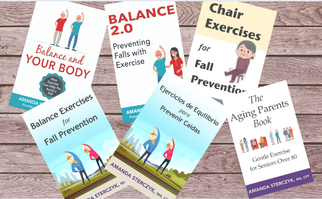 In the past week, I’ve had three separate requests for more details on the seniors’ exercise guides I have published. To date, I have written and published 6 books focused on helping seniors prevent life-altering falls and stay in their own homes longer. While there is some crossover with the books, each one has a unique focus. This month’s blog post will focus on these 6 books, but you can see a snapshot of all my books on my recently-updated website. These books are self-help exercise guides for caregivers, family members, and, most importantly, seniors. They all feature foundational exercises with step-by-step instructions and illustrations that they can use as a home-based exercise plan. The exercises don’t require special equipment or the need to get on the floor—any lying-down exercises are safe to perform on a bed. Each exercise also includes modifications on how to make it easier—or harder, in some of the more advanced books—depending on abilities. Falls are the leading cause of injury, emergency room visits, and hospitalizations for seniors in North America. The goal with my books is to help seniors increase their confidence—after all, the fear of falling contributes to the risk of falling—and improve their strength and balance so they won’t sustain a life-altering fall. Some of these titles are available for sale in Ottawa, while all of them can be ordered online from Amazon. And you can check out the table of contents with Amazon’s “Look Inside” feature if you want more details. Foundations of Balance and Fall Prevention (2-book series). The books Balance and Your Body and Balance 2.0 are standalone books, but can also be purchased together as the Foundations of Balance and Fall Prevention series. Both books are divided into three sections: The Problem, The Solution, and The Action Plan, which include a background on falls and fall prevention, personal stories, and targeted exercises. 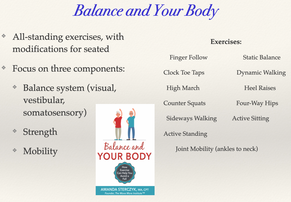 Balance and Your Body features all-standing exercises, with modifications for seated options where possible. It focuses on three components:
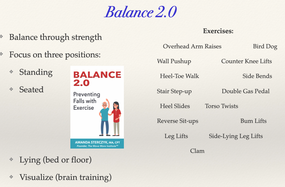 Balance 2.0 focuses on balance through strength. It features exercises in three positions: - standing - seated - lying (bed or floor) Also included are visualizations to help with brain training. Balance Exercises for Fall Prevention 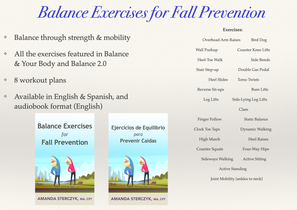 Balance Exercises for Fall Prevention is available in English and Spanish, and there is an audiobook of the English version. If you want just a straight exercise guide, this book has all the exercises featured in Balance and Your Body and Balance 2.0, while the background information on falls and fall prevention has been removed. It also includes 8 workout plans and an exercise breakdown by goal—balance, posture, strength, and flexibility. Chair Exercises for Fall Prevention 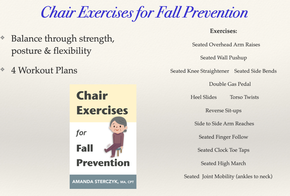 Chair Exercises for Fall Prevention features seated exercises only and includes 4 gentle, seated workout plans that focus on balance, posture, strength, and flexibility. The Aging Parents Book 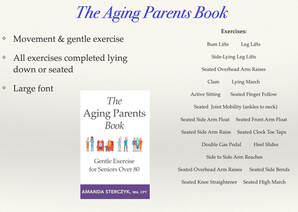 The Aging Parents Books: Gentle Exercise for Seniors Over 80 is a movement and gentle exercise guide. All of the exercises in this book are completed lying down on a bed or seated in a chair. The font size has been increased and the font style has been changed, to improve readability for those with eyesight challenges. If you’re still unsure about which book is right for you, or have any other questions, please feel free to reach out. 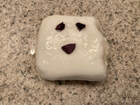 Hotel Hank. Image by Amanda Sterczyk Hotel Hank. Image by Amanda Sterczyk The following excerpt comes from my upcoming 13th book, Shawna's Outreach: When we each give a little, a lot gets done, by Shawna Thibodeau and Amanda Sterczyk. All royalties from this book will go directly to help people living in poverty and on the streets of Ottawa. It's called, "A day in the life of a donation." Let’s meet Hotel Hank, the complimentary bar of soap we all pick up on overnight hotel stays. His journey is one example of how even the smallest item can have a profound influence on someone’s life. Hotel Hank has been languishing on the stairs of a suburban Ottawa home for at least six months. Don’t let his diminutive appearance fool you: he has big dreams. All he wants is to meet up with his pal, Water, and help someone get clean. Never quite making it to a water source, his mission has been thwarted. Until today. 9:37 a.m. A careless footfall on the stairs sends Hotel Hank reeling, tumbling end over end until he lands at the bottom of the stairs, slightly askew. The person responsible for said relocation picks up Hotel Hank with one hand, as the other hand scrolls distractedly on a smartphone. 9:38 a.m. A friend’s social media post about Shawna’s Outreach fills the smartphone screen. Coincidentally, it’s a post detailing the need for toiletries. 9:39 a.m. Eyes shift from one hand to the other, from looking at Hotel Hank to reading the post about Shawna’s Outreach. A lightbulb goes off as a plan is formed. 9:40 a.m. A direct message arrives at Shawna’s Outreach: “Hi, I have a bar of soap that I’d like to donate. How can I get it to you?” 10:37 a.m. Hotel Hank is delivered to a local shop that serves as a drop-off point for Shawna’s Outreach. Shawna will be coming by in a few hours to gather the items in this donation bin. In the meantime, Hotel Hank chills with the other products that are awaiting delivery to their final destination. 12:44 p.m. Shawna arrives and collects Hotel Hank and the other donated items. She brings them to the back of her vehicle and begins distributing them in the half-filled bags. Hotel Hank joins a bag that already contains the usual items (drink, source of protein, socks, etc.). 3:00 p.m. After a few additional stops to pick up more donations and sort them into waiting bags, Shawna arrives in downtown Ottawa to begin sharing the bags with the unhoused people she meets on the street. 4:12 p.m. The bag containing Hotel Hank is handed to a young man sitting on the curb. He quickly opens the bag and begins pulling out the items. A smile forms across his face as he takes out Hotel Hank, and he tells Shawna that he hasn’t had a shower in four days. He’s looking forward to using his new bar of soap—Hotel Hank. 5:13 p.m. Hotel Hank’s dream comes true at last as he meets his pal, Water. More exuberant than soapy bubbles is his pride in helping this young homeless person. It’s been a good day all around. Copyright: Shawna Thibodeau and Amanda Sterczyk 2023, all rights reserved.
 If you’ve been following my Facebook author page, you may be aware that I’ve embarked on my first author collaboration. If not, keep reading to learn more. Earlier this year, I met Shawna Thibodeau at a women’s networking event. Shawna runs a grassroots initiative called Shawna’s Outreach. She accepts donations from all over the city and creates outreach bags to distribute to people living on the street.
At the event, Shawna received a generous cash donation to support her outreach work. Attendees were also invited to see how they could support in their own way, which leads us to today. My idea was to write a book—you know, give back through writing. The book is called Shawna's Outreach: When we each give a little, a lot gets done. Shawna and I are co-authors on this book, and we’re excited to let you know that it will be available for sale in a few months’ time. I have donated my time and services to write the book, but I have also recruited a volunteer editorial team. Everyone involved in producing this book is donating their time and services, so that all royalties can directly benefit Shawna's Outreach. The book will cover who Shawna is, how Shawna’s Outreach began, who donates to and who benefits from Shawna’s Outreach, and much more. We are telling the story of the homelessness crisis in Ottawa with hope and humour—in effort to demonstrate that every small act of kindness and sharing is important. As we look towards a fall book launch, we hope those of you in Ottawa will join us. If you are outside the Ottawa area and would like to donate directly to Shawna’s Outreach, please get in touch via email: [email protected]. You can also follow Shawna's Outreach on Facebook.
Introduction Inactivity can be a vicious cycle, particularly for frail, older seniors. Fear of falling keeps some seniors from getting up and moving more. Unfortunately, lack of movement further weakens muscles, stiffens joints, and reduces the ability to balance. The Aging Parents Book is a movement and gentle exercise guide. The purpose of this book is to show you, or your older loved one, how to do gentle movement-based exercises that will both feel good AND improve mobility and strength, as you (they) go about daily life. This is the sixth exercise book for seniors that I have published. It is different than my other Balance exercise guides, in that all of the exercises are completed either lying down or sitting in a chair. They still address the balance system, strength, posture, and joint mobility. These exercises will improve walking, reinforce good posture, and enhance ease of movement during day-to-day life. This book is all about gentle, low-key movement, so unlike my previous guides, there are no additional instructions on how to make the exercises harder. The font size has been increased and the font style has been changed, to improve readability for those with eyesight challenges. Exercise Sample: Foot Alphabet Copyright: Amanda Sterczyk 2023, all rights reserved.
|
Categories
All
Archives
July 2024
AuthorAmanda Sterczyk is an international author, Certified Personal Trainer (ACSM), an Exercise is Medicine Canada (EIMC) Fitness Professional, and a Certified Essentrics® Instructor. |




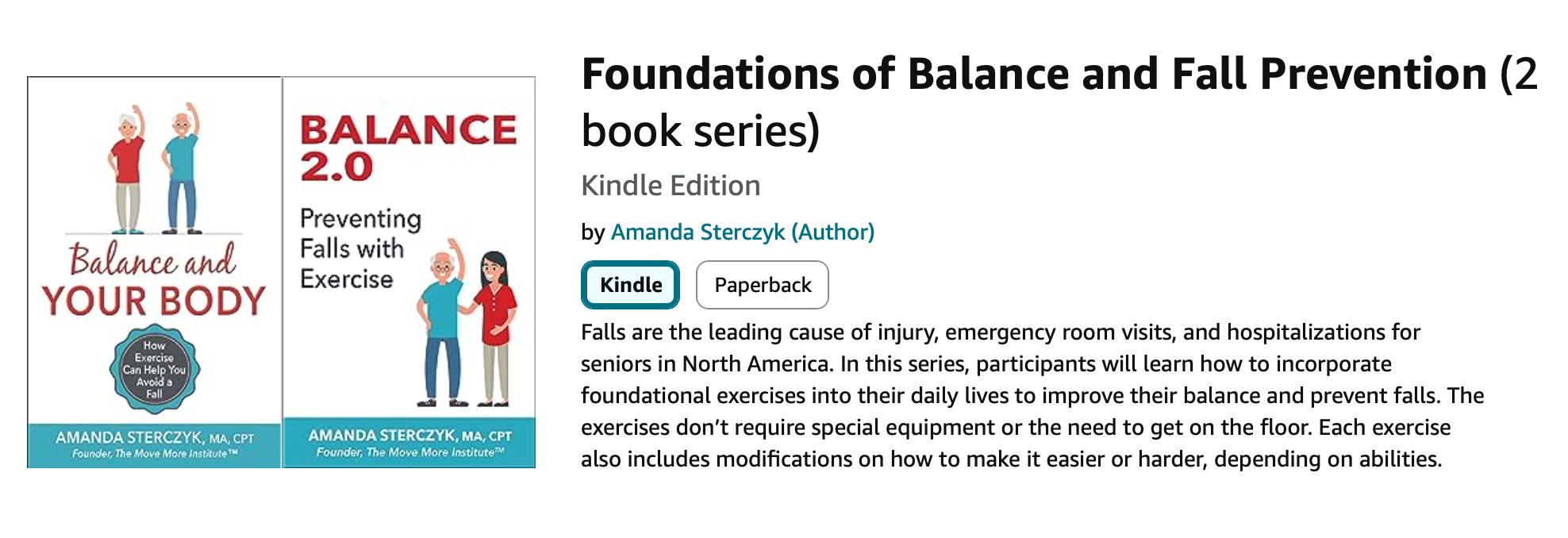
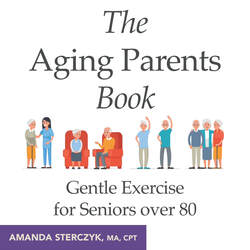
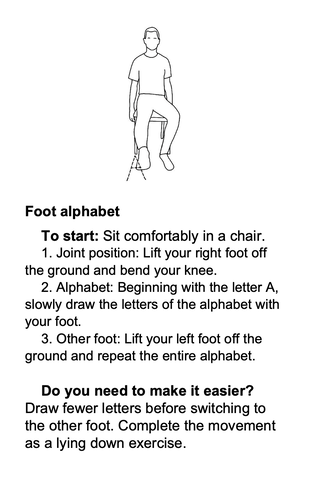
 RSS Feed
RSS Feed